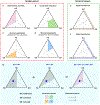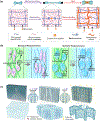Dissecting Biological and Synthetic Soft-Hard Interfaces for Tissue-Like Systems
- PMID: 34677943
- PMCID: PMC8917063
- DOI: 10.1021/acs.chemrev.1c00365
Dissecting Biological and Synthetic Soft-Hard Interfaces for Tissue-Like Systems
Abstract
Soft and hard materials at interfaces exhibit mismatched behaviors, such as mismatched chemical or biochemical reactivity, mechanical response, and environmental adaptability. Leveraging or mitigating these differences can yield interfacial processes difficult to achieve, or inapplicable, in pure soft or pure hard phases. Exploration of interfacial mismatches and their associated (bio)chemical, mechanical, or other physical processes may yield numerous opportunities in both fundamental studies and applications, in a manner similar to that of semiconductor heterojunctions and their contribution to solid-state physics and the semiconductor industry over the past few decades. In this review, we explore the fundamental chemical roles and principles involved in designing these interfaces, such as the (bio)chemical evolution of adaptive or buffer zones. We discuss the spectroscopic, microscopic, (bio)chemical, and computational tools required to uncover the chemical processes in these confined or hidden soft-hard interfaces. We propose a soft-hard interaction framework and use it to discuss soft-hard interfacial processes in multiple systems and across several spatiotemporal scales, focusing on tissue-like materials and devices. We end this review by proposing several new scientific and engineering approaches to leveraging the soft-hard interfacial processes involved in biointerfacing composites and exploring new applications for these composites.
Figures
























Similar articles
-
Rational Design of Semiconductor Nanostructures for Functional Subcellular Interfaces.Acc Chem Res. 2018 May 15;51(5):1014-1022. doi: 10.1021/acs.accounts.7b00555. Epub 2018 Apr 18. Acc Chem Res. 2018. PMID: 29668260 Free PMC article.
-
Soft-Hard Composites for Bioelectric Interfaces.Trends Chem. 2020 Jun;2(6):519-534. doi: 10.1016/j.trechm.2020.03.005. Epub 2020 Apr 23. Trends Chem. 2020. PMID: 34296076 Free PMC article.
-
Making the Most of your Electrons: Challenges and Opportunities in Characterizing Hybrid Interfaces with STEM.Mater Today (Kidlington). 2021 Nov;50:100-115. doi: 10.1016/j.mattod.2021.05.006. Epub 2021 Jun 19. Mater Today (Kidlington). 2021. PMID: 35241968 Free PMC article.
-
Multiscale Soft-Hard Interface Design for Flexible Hybrid Electronics.Adv Mater. 2020 Apr;32(15):e1902278. doi: 10.1002/adma.201902278. Epub 2019 Aug 29. Adv Mater. 2020. PMID: 31468635 Review.
-
Rational Design of Soft-Hard Interfaces through Bioinspired Engineering.Small. 2023 Jan;19(1):e2204498. doi: 10.1002/smll.202204498. Epub 2022 Oct 13. Small. 2023. PMID: 36228093 Review.
Cited by
-
Revolutionizing biomedicine: advancements, applications, and prospects of nanocomposite macromolecular carbohydrate-based hydrogel biomaterials: a review.RSC Adv. 2023 Dec 4;13(50):35251-35291. doi: 10.1039/d3ra07391b. eCollection 2023 Nov 30. RSC Adv. 2023. PMID: 38053691 Free PMC article. Review.
-
Tissue-embedded stretchable nanoelectronics reveal endothelial cell-mediated electrical maturation of human 3D cardiac microtissues.Sci Adv. 2023 Mar 10;9(10):eade8513. doi: 10.1126/sciadv.ade8513. Epub 2023 Mar 8. Sci Adv. 2023. PMID: 36888704 Free PMC article.
-
Ligand-binding assay based on microfluidic chemotaxis of porphyrin receptors.Chem Sci. 2022 Nov 9;13(47):14106-14113. doi: 10.1039/d2sc04849c. eCollection 2022 Dec 7. Chem Sci. 2022. PMID: 36540820 Free PMC article.
-
Interpretable Machine Learning for Evaluating Nanogenerators' Structural Design.ACS Nano. 2025 Apr 15;19(14):14456-14466. doi: 10.1021/acsnano.5c02525. Epub 2025 Apr 7. ACS Nano. 2025. PMID: 40189909 Free PMC article.
-
Direct Metal Transfer on Swellable Hydrogel with Dehydration-Induced Physical Adhesion.ACS Omega. 2024 Oct 6;9(41):42261-42266. doi: 10.1021/acsomega.4c04774. eCollection 2024 Oct 15. ACS Omega. 2024. PMID: 39431084 Free PMC article.
References
-
- Kato T; Yoshio M; Ichikawa T; Soberats B; Ohno H; Funahashi M Transport of ions and electrons in nanostructured liquid crystals. Nat. Rev. Mater 2017, 2, 1–20.
-
- Yang CH; Suo ZG Hydrogel ionotronics. Nat. Rev. Mater 2018, 3, 125–142.
-
- Wegst UGK; Bai H; Saiz E; Tomsia AP; Ritchie RO Bioinspired structural materials. Nat. Mater 2015, 14, 23–36. - PubMed
-
- Whittell GR; Hager MD; Schubert US; Manners I Functional soft materials from metallopolymers and metallosupramolecular polymers. Nat. Mater 2011, 10, 176–188. - PubMed
-
- Weiss RG The past, present, and future of molecular gels. what is the status of the field, and where is it going? J. Am. Chem. Soc 2014, 136, 7519–7530. - PubMed
Publication types
MeSH terms
Grants and funding
LinkOut - more resources
Full Text Sources
Miscellaneous

